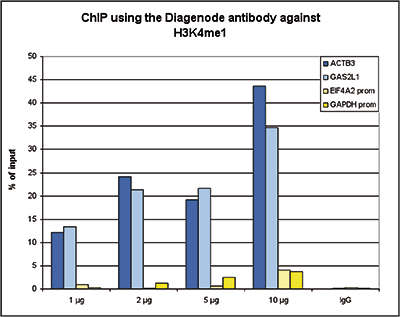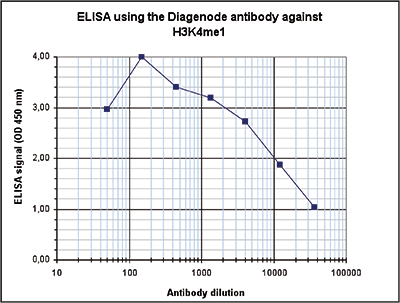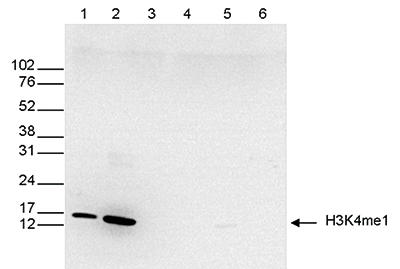
H3K4me1 polyclonal antibody
| 貨號 |
C15410194-10/C15410194-50 |
售價 |
咨詢 |
| 規(guī)格 |
10ug/50ug |
CAS號 |
|
- 產(chǎn)品簡介
- 相關(guān)產(chǎn)品
Polyclonal antibody raised in rabbit against the region of histone H3 containing the monomethylated lysine 4 (H3K4me1), using a KLH-conjugated synthetic peptide.
|
Lot
|
A1862D
|
|
Concentration
|
1.5 μg/μl
|
|
Species reactivity
|
Human, Mouse, Drosophila, wide range expected
|
|
Type
|
Polyclonal, ChIP grade, ChIP-seq grade
|
|
Purity
|
Affinity purified polyclonal antibody.
|
|
Host
|
Rabbit
|
|
Storage Conditions
|
Store at -20°C; for long storage, store at -80°C. Avoid multiple freeze-thaw cycles.
|
|
Storage Buffer
|
PBS containing 0.05% azide and 0.05% ProClin 300.
|
|
Precautions
|
This product is for research use only. Not for use in diagnostic or therapeutic procedures.
|
|
Applications
|
Suggested dilution
|
References
|
|
ChIP/ChIP-seq *
|
0.5-1 μg/IP
|
Fig 1, 2, 3
|
|
CUT&TAG
|
1 μg
|
Fig 4
|
|
ELISA
|
1:400
|
Fig 5
|
|
Dot Blotting/Peptide array
|
1:5,000/1:2,000
|
Fig 6
|
|
Western Blotting
|
1:500
|
Fig 7
|
|
Immunofluorescence
|
1:200
|
Fig 8
|
* Please note that the optimal antibody amount per IP should be determined by the end-user. We recommend testing 0.5-5 μg per IP.
-
Validation data
A. 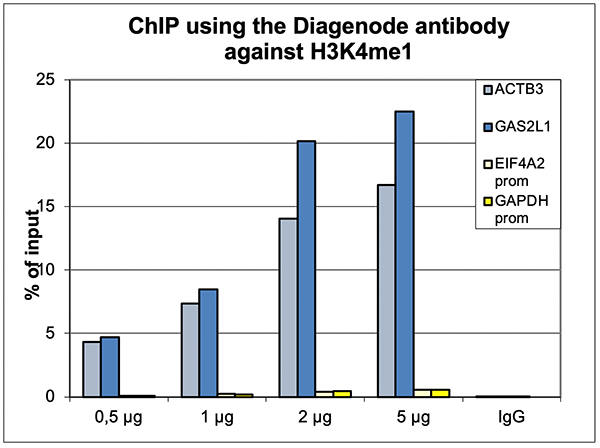
B. 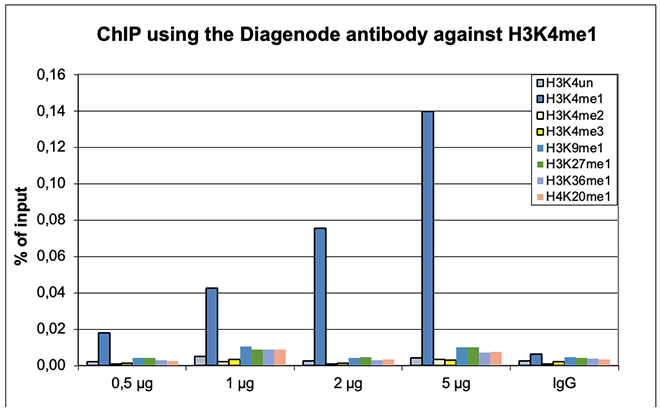
Figure 1. ChIP results obtained with the Diagenode antibody directed against H3K4me1
ChIP was performed with the Diagenode antibody against H3K4me1 (Cat. No. C15410194) on sheared chromatin from 500,000 HeLaS3 cells using the “iDeal ChIP-seq” kit (Cat. No. C01010051). The chromatin was spiked with a panel of in vitro assembled nucleosomes, each containing a specific lysine methylation. A titration of the antibody consisting of 0.5, 1, 2 and 5 μg per ChIP experiment was analysed. IgG (2 μg/IP) was used as negative IP control. Figure 1A. Quantitative PCR was performed with primers for a region surrounding the ACTB and GAS2L1 genes, used as positive controls, and for the promoters of the GAPDH and EIF4A2 genes, used as negative controls. The graph shows the recovery, expressed as a % of input (the relative amount of immunoprecipitated DNA compared to input DNA after qPCR analysis). Figure 1B. Recovery of the nucleosomes carrying the H3K4me1, H3K4me2, H3K4me3, H3K9me1, H3K27me1, H3K36me1, H4K20me1 and the unmodified H3K4 as determined by qPCR. The figure clearly shows the antibody is very specific in ChIP for the H3K4me1 modification.
Figure 2. ChIP results obtained with the Diagenode antibody directed against H3K4me1
ChIP assays were performed using human K562 cells, the Diagenode antibody against H3K4me1 (Cat. No. C15410194) and optimized PCR primer pairs for qPCR. ChIP was performed with the “iDeal ChIP-seq” kit (Cat. No. C01010051), using sheared chromatin from 100,000 cells. A titration consisting of 1, 2, 5 and 10 μg of antibody per ChIP experiment was analyzed. IgG (1 μg/IP) was used as a negative IP control. Quantitative PCR was performed with primers for a region surrounding the ACTB and GAS2L1 gene, respectively, used as positive controls, and for the promoters of the GAPDH and EIF4A2 genes, used as negative controls. Figure 2 shows the recovery, expressed as a % of input (the relative amount of immunoprecipitated DNA compared to input DNA after qPCR analysis).
Figure 3. ChIP-seq results obtained with the Diagenode antibody directed against H3K4me1
ChIP was performed on sheared chromatin from 100,000 K562 cells with the “iDeal ChIP-seq” kit (Cat. No. C01010051) using 1 μg of the Diagenode antibody against H3K4me1 (Cat. No. C15410194) as described above. The IP’d DNA was subsequently analysed on an Illumina Genome Analyzer. Library preparation, cluster generation and sequencing were performed according to the manufacturer’s instructions. The 36 bp tags were aligned to the human genome using the ELAND algorithm. Figure 3A and B show the H3K4me1 signal in two genomic regions containing the ACTB and GAS2L1 positive controls. The position of the amplicon used for ChIP-qPCR is indicated by an arrow. Figure 3C shows the H3K4me1 peak distribution along a 1 Mb genomic region of chromosome 5.
A.  B.
B. 
Figure 4. Cut&Tag results obtained with the Diagenode antibody directed against H3K4me1
CUT&TAG (Kaya-Okur, H.S., Nat Commun 10, 1930, 2019) was performed on 50,000 K562 cells using 1 μg of the Diagenode antibody against H3K4me1 (cat. No. C15410194) and the Diagenode pA-Tn5 transposase (C01070001). The libraries were subsequently analysed on an Illumina NextSeq 500 sequencer (2x75 paired-end reads) according to the manufacturer's instructions. The tags were aligned to the human genome (hg19) using the BWA algorithm. Figure 4 shows the peak distribution in 2 genomic regions surrounding the GAPDH gene on chromosome 12 and the FOS gene on chromosome 14 (figure 4A and B, respectively).
Figure 5. Determination of the antibody titer
To determine the titer of the antibody, an ELISA was performed using a serial dilution of the Diagenode antibody against H3K4me1 (Cat. No. C15410194). The antigen used was a peptide containing the histone modification of interest. By plotting the absorbance against the antibody dilution (Figure 5), the titer of the antibody was estimated to be 1:10,300.
A.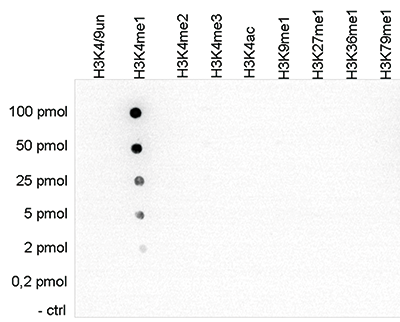
B.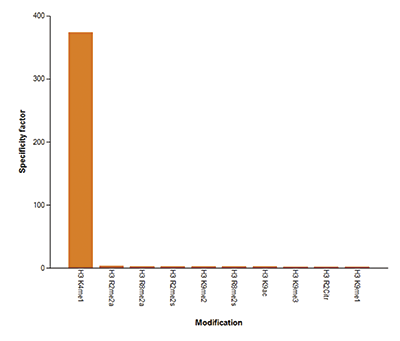
Figure 6. Cross reactivity tests using the Diagenode antibody directed against H3K4me1
Figure 6A. To test the cross reactivity of the Diagenode antibody against H3K4me1 (Cat. No. C15410194), a Dot Blot analysis was performed with peptides containing other histone modifications and the unmodified H3K4. One hundred to 0.2 pmol of the respective peptides were spotted on a membrane. The antibody was used at a dilution of 1:5,000. Figure 6A shows a high specificity of the antibody for the modification of interest.
Figure 6B. The specificity of the antibody was further demonstrated by peptide array analyses on an array containing 384 peptides with different combinations of modifications from histone H3, H4, H2A and H2B. The antibody was used at a dilution of 1:2,000. Figure 6B shows the specificity factor, calculated as the ratio of the average intensity of all spots containing the mark, divided by the average intensity of all spots not containing the mark.
Figure 7. Western blot analysis using the Diagenode antibody directed against H3K4me1
Western blot was performed on whole cell (25 μg, lane 1) and histone extracts (15 μg, lane 2) from HeLa cells, and on 1 μg of recombinant histone H2A, H2B, H3 and H4 (lane 3, 4, 5 and 6, respectively) using the Diagenode antibody against H3K4me1 (Cat. No. C15410194). The antibody was diluted 1:500 in TBS-Tween containing 5% skimmed milk. The position of the protein of interest is shown on the right, the marker (in kDa) is shown on the left.
Figure 8. Immunofluorescence using the Diagenode antibody directed against H3K4me1
HeLa cells were stained with the Diagenode antibody against H3K4me1 (Cat. No. C15410194) and with DAPI. Cells were fixed with 4% formaldehyde for 10’ and blocked with PBS/TX-100 containing 5% normal goat serum and 1% BSA. The cells were immunofluorescently labeled with the H3K4me1 antibody (left) diluted 1:200 in blocking solution followed by an anti-rabbit antibody conjugated to Alexa488. The middle panel shows staining of the nuclei with DAPI. A merge of the two stainings is shown on the right.






